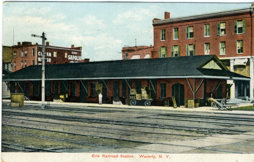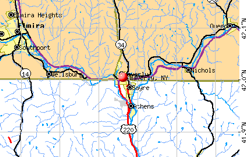Barton - Waverly
Waverly is the largest village in Tioga County, New York, United States. It is located southeast of Elmira in the Southern Tier region. This village was incorporated as the southwest part of the town of Barton in 1854. The village name is attributed to Joseph "Uncle Joe" Hallett,[3] founder of its first Fire Department and pillar of the community, who conceived the name by dropping the 2nd "e" from the name of his favorite author's novel, Waverley by Sir Walter Scott. The village hall is listed on the National Historic Places list.
Waverly is part of the Binghamton Metropolitan Statistical Area.
History
John Shepard was perhaps the most important early settler of this area. He arrived here after having worked as a clerk at Sheshequin PA in the employ of Matthias Hollenback. He built the first and only mill within 50 miles of this locale, in the early 1700s, and it soon became known as Milltown. The town was established near Cayuta Creek, also known as Shepard's Creek, which provided water power for the flour mills and sawmills in the area. Originally the town was located in Pennsylvania until it was resurveyed and it was found to be mistakenly 1/4 of a mile north which moved the town into New York State. He continued to purchase extensive tracts of land in the area and soon this burgeoning area came to be known as Factoryville, with an adjacent smaller town named Villemont also becoming established. The community began to thrive upon the arrival of the Erie Railroad and Broad Street, the main thoroughfare, flourished because of its proximity to the railroad. Approximately forty-one trains entered the village per day and 6,000 people lived in the village in the early 1900s. The town possessed seven hotels during the railroading period along with grocery stores, restaurants, and bars. The largest celebration ever in the village was the August, 26th 1910 Old Home Celebration which lasted four hours and packed the streets with spectators. Several factories of historical significance contributed to a flourishing period in Waverly's development. They included the Hall-Lyons furniture factory which was located on Broad Street and the Manoil Manufacturing Co. whose prominence as a toy company, especially from 1937-1941 when it produced hollow-cast toy soldiers (sometimes called dime store soldiers) along with toy airplanes and cars, was located on Providence Street. "Businesses in the twentieth century included the Spencer Glove Company and the Waverly Sun newspaper, both owned by Hart I. Seely and located in Waverly; the Tioga Mills, Inc., a feed mill company and Agway, Country Foods Division of Syracuse, N. Y. as a pet food plant. Others are the Food and Drug Research Laboratories, located on Route 17C, just east of Waverly, State Line Auto Auction, O’Brien’s Inn, and one of the most interesting, the J. E. Ranch."[4] The 1940s and 1950s were also the heyday of Colonel Jim Eskew's famous J. E. Rodeo organization,[5] the only rodeo ranch east of the Mississippi River.[5] The rodeo traveled throughout the Mid Atlantic and New England states.[5] The only major battle of the Sullivan Expedition, the Battle of Newtown, took place just outside of Waverly to the west.
Geography
The Chemung River skirts the western edge of the village, and joins the Susquehanna River about 6 miles (9.7 km) south of the village, in Athens Township, Pennsylvania. Another Susquehanna tributary, Cayuta Creek, also known locally as Shepard's Creek, flows through the eastern part of the village before joining the Susquehanna in Sayre, Pennsylvania.
Waverly is so close to New York State's southern border that the village is part of a much larger community that runs into Bradford County, Pennsylvania. Waverly combines with South Waverly, Sayre and Athens, Pennsylvania to make up the larger community of "The Valley", which just happens to have a state border running through it. Waverly is also a short distance from the border of Chemung County to the west.
Downtown Waverly spans along an area adjacent to and immediately North of Interstate 86, which is an upgrade of the existing New York State Route 17 that was formerly known as the Southern Tier Expressway. Access to Interstate 86 is available at both eastern and western points of the village. New York State Route 17C and New York State Route 34 also intersect in the eastern end of this village. In addition, the northern terminus for U.S. Route 220 is at NY 17C (Chemung Street) in the west end of the village.
Notable people
-
■Geoff Bodine - Professional NASCAR race car driver, inventor of the Bo-Dyn Bobsled, a graduate of Waverly High School[7]
-
■Brett Bodine - Professional NASCAR race car driver, graduate of Waverly High School[8][9]
-
■Todd Bodine - Professional NASCAR race car driver, graduate of Waverly High School
-
■Jim Farr - Pro baseball player, Born in Waverly
-
■Linda Bangs-Urban - Saxophonist, Born in Waverly
-
■John Marshall - Cartoonist, Born in Waverly
-
■Bernard L. Oser - Columbia University professor, formerly researched at Food and Drug Research Laboratories, Inc. in Waverly
-
■
Communities in Waverly
-
■East Waverly on the eastern side of Waverly
-
■North Waverly on the north side of Waverly
-
■Ellistown on the eastern side of Waverly as well
-
■Lockwood on the north side of Waverly as well
Sports History
Waverly was once home to a professional baseball team in 1901, as the Waverly Wagonmakers. The team went under when the New York State League was dissolved in 1917. Waverly is also home to the Waverly Little League, it was founded in 1949. The Waverly School District also has football, baseball, basketball, bowling, golf, tennis, soccer, wrestling, track, and cross country, teams. Waverly's wrestling team achieves consistent state and national rankings. Waverly is also home to many smaller bowling leagues that have matches at the Valley Bowling Center in Waverly. Waverly Memorial Stadium is located in Waverly. Soccer and Football are played at the stadium.
Recent events
-
■Two Rivers State Park
Despite designation of 600 acres (2.4 km2) of wooded, picturesque land surrounding the Waverly Reservoir property and encompassing Waverly Glen park, as Two Rivers State Park in 2005, efforts are still ongoing between local and state officials to develop a Master Plan for adding more amenities to the park. At the present time, hiking and biking trails are available, as well as family recreation with picnic tables, a basketball court, two tennis courts, children's gym equipment, covered pavilions, water taps and barbecue fireplaces. More funding is essential and expanded features such as river access (which is 2 to 3 miles (4.8 km) away) and nearby golfing privileges would attract more visitors and provide a big boost for the local economy.
-
■Historical Downtown Preservation
A large portion of the the former Snyder Hotel building in downtown Waverly collapsed, during a severe weather storm in the summer of 2007, requiring emergency efforts to clear fallen bricks, wood and other building products and restore the safety of downtown operations. Despite ongoing concerns regarding safety issues with some of the historic buildings along Broad Street, progress has been slowed as far as development considerations on whether to tear down or renovate these buildings. Waverly sought financial assistance, under the state's Restore New York funding program, but was unable to secure any relief. A tax increase referendum conducted 11 December 2008 resulted in voter approval to secure financing for what has subsequently led to the purchase and ongoing renovation for an anticipated move of all village municipal services into the former Ithaca Street School, after outgrowing the available space at historic Waverly Village Hall.
Information from Wikipedia - May 23, 2010
Waverly



110 Front Street, Owego, NY 13827 Phone: 607-687-2460 Email: museum@tiogahistory.org















